Fiducial Reference Measurement for Greenhouse Gases (FRM4GHG)
Abstract
1. Introduction
2. Materials and Methods
2.1. FRM4GHG Campaign Overview
2.2. Instrument Description and Adaptation to Achieve FRM Status
2.2.1. Bruker IFS 125HR
2.2.2. Bruker EM27/SUN
2.2.3. Bruker Vertex70
2.2.4. Bruker IRCube
2.2.5. Laser Heterodyne Spectro-Radiometer (LHR)
2.2.6. AirCore
3. Results
3.1. First Phase of the Intercomparison Campaign
3.1.1. Intercomparison Results of the Total Column from AirCore and TCCON
3.1.2. Intercomparison Results of the Total Column from EM27/SUN and TCCON
3.1.3. Intercomparison Results of the Total Column from Vertex70 and TCCON
3.1.4. Intercomparison Results of the Total Column from IRCube and TCCON
3.2. Laser Heterodyne Spectro-Radiometer
- A dedicated solar tracker using the internal camera of the LHR for the FOV control feedback is needed to fully decouple the LHR FOV from other instruments’ settings. A miniature one-inch aperture alt-azimuth tracker has been developed and tested; it will be part of any subsequent measurement campaigns;
- The background anomaly, preventing the correct estimation of the zero transmission, has been studied in detail, and its physical origin is traced back to detector responsivity modulation. This effect turns into an artifactual zero transmission offset scaling linearly with the solar power input. The most immediate remedy consists of limiting the spectral bandwidth of the input radiation;
- A significant contribution to the biases was identified to instrument internal temperature variations. The associated physical process is still being investigated.
3.3. Results from the Vertex70 Upgrades
3.3.1. Formaldehyde (HCHO) Measurements Using the Vertex70 Spectrometer
3.3.2. Carbonyl Sulfide (OCS) Measurements Using the Vertex70 Spectrometer
3.3.3. Nitrous Oxide (N2O) and Methane (CH4) Measurements Using Vertex70
3.3.4. Making the Vertex70 Type of Spectrometers Portable and Autonomous
3.4. Results from IRCube Upgrades
3.5. FRM4GHG Traveling Standard
3.6. Software Developments to Achieve FRM Quality Data
- The processing now supports the Invenio and IRCube spectrometers investigated in the framework of FRM4GHG. Specifically, PREPROCESS now also handles single-sided interferograms as delivered by these spectrometers. Because the presence of residual phase errors is much more critical in the case of single-sided interferograms, a novel phase correction scheme, which constructs a smooth analytical phase, has been developed and implemented;
- An extensive spectroscopy update was performed. Individual line lists and the total internal partition sums have been updated to match the HITRAN 2020 data. At the time of compilation, no line-mixing parameters for CH4 were available in HITRAN, so the required parameters were deduced from cell measurements of methane–air mixtures performed at KIT. The solar line list provided by Geoff Toon for GGG2020 was incorporated for describing the solar spectrum;
- The airmass-dependent modeling of atmospheric spectra has been refined, especially for high solar zenith angles. In order to save computational time and storage, the cross-sections are not tabulated as a function of vertical coordinate (e.g., pressure) but refer to the integrated absorption for the whole atmosphere. This approach requires a polynomial expansion for quantifying the deviation versus a simple model of a plane parallel atmosphere without refraction. The number of fitted parameters used in the expansion has been increased from four to five;
- The empirical adjustments of COCCON Xgas products (airmass-independent and airmass-dependent corrections in INVERS) have been updated, now involving several EM27/SUN spectrometers and two TCCON reference sites (TCCON Karlsruhe and TCCON Sodankylä). The new GGG2020 reanalysis provided by TCCON has been used as a target reference. Because a significant slope change has been found when projecting TCCON XCH4 results versus XH2O using GGG2014 or GGG2020 data, a further empirical adjustment has been implemented in the post-processing of PROFFAST, which allows for an ad hoc slope correction of Xgas versus XH2O;
- The latest PROFFAST release includes a revised version of the wrapper with significantly extended functionalities [40].
3.7. AirCore Developments and Results
4. Achieving FRM Status
5. Discussion and Outlook
Author Contributions
Funding
Data Availability Statement
Acknowledgments
Conflicts of Interest
References
- Goryl, P.; Fox, N.; Donlon, C.; Castracane, P. Fiducial reference measurements (frms): What are they? Remote Sens. 2023, 15, 5017. [Google Scholar] [CrossRef]
- Wunch, D.; Toon, G.C.; Blavier, J.-F.L.; Washenfelder, R.A.; Notholt, J.; Connor, B.J.; Griffith, D.W.T.; Sherlock, V.; Wennberg, P.O. The total carbon column observing network. Philos. Trans. R. Soc. A Math. Phys. Eng. Sci. 2011, 369, 2087–2112. [Google Scholar] [CrossRef] [PubMed]
- Inoue, M.; Morino, I.; Uchino, O.; Nakatsuru, T.; Yoshida, Y.; Yokota, T.; Wunch, D.; Wennberg, P.O.; Roehl, C.M.; Griffith, D.W.T.; et al. Bias corrections of gosat swir xco2 and xch4 with tccon data and their evaluation using aircraft measurement data. Atmos. Meas. Tech. 2016, 9, 3491–3512. [Google Scholar] [CrossRef]
- Wunch, D.; Wennberg, P.O.; Osterman, G.; Fisher, B.; Naylor, B.; Roehl, C.M.; O’Dell, C.; Mandrake, L.; Viatte, C.; Kiel, M.; et al. Comparisons of the orbiting carbon observatory-2 (oco-2) xco2 measurements with tccon. Atmos. Meas. Tech. 2017, 10, 2209–2238. [Google Scholar] [CrossRef]
- Sha, M.K.; Langerock, B.; Blavier, J.-F.L.; Blumenstock, T.; Borsdorff, T.; Buschmann, M.; Dehn, A.; De Mazière, M.; Deutscher, N.M.; Feist, D.G.; et al. Validation of methane and carbon monoxide from sentinel-5 precursor using tccon and ndacc-irwg stations. Atmos. Meas. Tech. 2021, 14, 6249–6304. [Google Scholar] [CrossRef]
- Mazière, M.D.; Thompson, A.M.; Kurylo, M.J.; Wild, J.D.; Bernhard, G.; Blumenstock, T.; Braathen, G.O.; Hannigan, J.W.; Lambert, J.C.; Leblanc, T.; et al. The network for the detection of atmospheric composition change (ndacc): History, status and perspectives. Atmos. Chem. Phys. 2018, 18, 4935–4964. [Google Scholar] [CrossRef]
- Sha, M.K.; De Mazière, M.; Notholt, J.; Blumenstock, T.; Chen, H.; Dehn, A.; Griffith, D.W.T.; Hase, F.; Heikkinen, P.; Hermans, C.; et al. Intercomparison of low- and high-resolution infrared spectrometers for ground-based solar remote sensing measurements of total column concentrations of CO2, CH4, and CO. Atmos. Meas. Tech. 2020, 13, 4791–4839. [Google Scholar] [CrossRef]
- Karion, A.; Sweeney, C.; Tans, P.; Newberger, T. Aircore: An innovative atmospheric sampling system. J. Atmos. Ocean. Technol. 2010, 27, 1839–1853. [Google Scholar] [CrossRef]
- Kivi, R.; Heikkinen, P. Fourier transform spectrometer measurements of column co2 at sodankylä, finland. Geosci. Instrum. Methods Data Syst. 2016, 5, 271–279. [Google Scholar] [CrossRef]
- Wunch, D.; Toon, G.C.; Sherlock, V.; Deutscher, N.M.; Liu, C.; Feist, D.G.; Wennberg, P.O. The Total Carbon Column Observing Network’s GGG2014 Data Version; Technical Report; Carbon Dioxide Information Analysis Center, Oak Ridge National Laboratory: Oak Ridge, TN, USA, 2015. [Google Scholar]
- Laughner, J.L.; Toon, G.C.; Mendonca, J.; Petri, C.; Roche, S.; Wunch, D.; Blavier, J.-F.; Griffith, D.W.T.; Heikkinen, P.; Keeling, R.F.; et al. The total carbon column observing network’s ggg2020 data version. Earth Syst. Sci. Data Discuss. 2023, 16, 2197–2260. [Google Scholar] [CrossRef]
- Gisi, M.; Hase, F.; Dohe, S.; Blumenstock, T.; Simon, A.; Keens, A. Xco2-measurements with a tabletop fts using solar absorption spectroscopy. Atmos. Meas. Tech. 2012, 5, 2969–2980. [Google Scholar] [CrossRef]
- Hase, F.; Frey, M.; Kiel, M.; Blumenstock, T.; Harig, R.; Keens, A.; Orphal, J. Addition of a channel for xco observations to a portable ftir spectrometer for greenhouse gas measurements. Atmos. Meas. Tech. 2016, 9, 2303–2313. [Google Scholar] [CrossRef]
- Weidmann, D. 4-atmospheric trace gas measurements using laser heterodyne spectroscopy. In Advances in Spectroscopic Monitoring of the Atmosphere; Elsevier: Amsterdam, The Netherlands, 2021; pp. 159–223. ISBN 978-0-12-815014-6. [Google Scholar] [CrossRef]
- Weidmann, D.; Reburn, W.J.; Smith, K.M. Ground-based prototype quantum cascade laser heterodyne radiometer for atmospheric studies. Rev. Sci. Instrum. 2007, 78, 073107. [Google Scholar] [CrossRef] [PubMed]
- Hoffmann, A.; Macleod, N.A.; Huebner, M.; Weidmann, D. Thermal infrared laser heterodyne spectroradiometry for solar occultation atmospheric co2 measurements. Atmos. Meas. Tech. 2016, 9, 5975–5996. [Google Scholar] [CrossRef]
- Tsai, T.R.; Rose, R.A.; Weidmann, D.; Wysocki, G. Atmospheric vertical profiles of o3, n2o, ch4, ccl2f2, and h2o retrieved from external-cavity quantum-cascade laser heterodyne radiometer measurements. Appl. Opt. 2012, 51, 8779–8792. [Google Scholar] [CrossRef]
- Dirksen, R.J.; Sommer, M.; Immler, F.J.; Hurst, D.F.; Kivi, R.; Vömel, H. Reference quality upper-air measurements: Gruan data processing for the vaisala rs92 radiosonde. Atmos. Meas. Tech. 2014, 7, 4463–4490. [Google Scholar] [CrossRef]
- Frey, M.; Sha, M.K.; Hase, F.; Kiel, M.; Blumenstock, T.; Harig, R.; Surawicz, G.; Deutscher, N.M.; Shiomi, K.; Franklin, J.E.; et al. Building the collaborative carbon column observing network (coccon): Long-term stability and ensemble performance of the em27/sun fourier transform spectrometer. Atmos. Meas. Tech. 2019, 12, 1513–1530. [Google Scholar] [CrossRef]
- Brownsword, R.; Doniki, S.; Weidmann, D. Harwell TCCON Site Accreditation Application Report. 1.3, 1–35. Zenodo 2023. [Google Scholar] [CrossRef]
- Stavrakou, T.; Müller, J.-F.; De Smedt, I.; Van Roozendael, M.; van der Werf, G.R.; Giglio, L.; Guenther, A. Evaluating the performance of pyrogenic and biogenic emission inventories against one decade of space-based formaldehyde columns. Atmos. Chem. Phys. 2009, 9, 1037–1060. [Google Scholar] [CrossRef]
- Vigouroux, C.; Aquino, C.A.B.; Bauwens, M.; Becker, C.; Blumenstock, T.; De Mazière, M.; García, O.; Grutter, M.; Guarin, C.; Hannigan, J.; et al. Ndacc harmonized formaldehyde time series from 21 ftir stations covering a wide range of column abundances. Atmos. Meas. Tech. 2018, 11, 5049–5073. [Google Scholar] [CrossRef]
- Vigouroux, C.; Langerock, B.; Aquino, C.A.B.; Blumenstock, T.; Cheng, Z.; De Mazière, M.; De Smedt, I.; Grutter, M.; Hannigan, J.W.; Jones, N.; et al. Tropomi–sentinel-5 precursor formaldehyde validation using an extensive network of ground-based fourier-transform infrared stations. Atmos. Meas. Tech. 2020, 13, 3751–3767. [Google Scholar] [CrossRef]
- Goldan, P.D.; Fall, R.; Kuster, W.C.; Fehsenfeld, F.C. Uptake of cos by growing vegetation: A major tropospheric sink. J. Geophys. Res. Atmos. 1988, 93, 14186–14192. [Google Scholar] [CrossRef]
- Campbell, J.E.; Carmichael, G.R.; Chai, T.; Mena-Carrasco, M.; Tang, Y.; Blake, D.R.; Blake, N.J.; Vay, S.A.; Collatz, G.J.; Baker, I.; et al. Photosynthetic control of atmospheric carbonyl sulfide during the growing season. Science 2008, 322, 1085–1088. [Google Scholar] [CrossRef] [PubMed]
- Whelan, M.E.; Lennartz, S.T.; Gimeno, T.E.; Wehr, R.; Wohlfahrt, G.; Wang, Y.; Kooijmans, L.M.J.; Hilton, T.W.; Belviso, S.; Peylin, P.; et al. Reviews and syntheses: Carbonyl sulfide as a multi-scale tracer for carbon and water cycles. Biogeosciences 2018, 15, 3625–3657. [Google Scholar] [CrossRef]
- Wang, Y.; Deutscher, N.M.; Palm, M.; Warneke, T.; Notholt, J.; Baker, I.; Berry, J.; Suntharalingam, P.; Jones, N.; Mahieu, E.; et al. Towards understanding the variability in biospheric co2 fluxes: Using ftir spectrometry and a chemical transport model to investigate the sources and sinks of carbonyl sulfide and its link to co2. Atmos. Chem. Phys. 2016, 16, 2123–2138. [Google Scholar] [CrossRef]
- Hannigan, J.W.; Ortega, I.; Shams, S.B.; Blumenstock, T.; Campbell, J.E.; Conway, S.; Flood, V.; Garcia, O.; Griffith, D.; Grutter, M.; et al. Global atmospheric ocs trend analysis from 22 ndacc stations. J. Geophys. Res. Atmos. 2022, 127, e2021JD035764. [Google Scholar] [CrossRef]
- Zhou, M.; Langerock, B.; Sha, M.K.; Hermans, C.; Kumps, N.; Kivi, R.; Heikkinen, P.; Petri, C.; Notholt, J.; Chen, H.; et al. Atmospheric n2o and ch4 total columns retrieved from low-resolution fourier transform infrared (ftir) spectra (bruker vertex 70) in the mid-infrared region. Atmos. Meas. Tech. 2023, 16, 5593–5608. [Google Scholar] [CrossRef]
- Neefs, E.; De Mazière, M.; Scolas, F.; Hermans, C.; Hawat, T. Barcos, an automation and remote control system for atmospheric observations with a bruker interferometer. Rev. Sci. Instrum. 2007, 78, 035109. [Google Scholar] [CrossRef]
- Heinle, L.; Chen, J. Automated enclosure and protection system for compact solar-tracking spectrometers. Atmos. Meas. Tech. 2018, 11, 2173–2185. [Google Scholar] [CrossRef]
- ICOS RI. ICOS Atmosphere Station Specifications v2.0; Laurent, O., Ed.; ICOS ERIC: Helsinki, Finland, 2020. [Google Scholar] [CrossRef]
- Wunch, D.; Toon, G.C.; Wennberg, P.O.; Wofsy, S.C.; Stephens, B.B.; Fischer, M.L.; Uchino, O.; Abshire, J.B.; Bernath, P.; Biraud, S.C.; et al. Calibration of the total carbon column observing network using aircraft profile data. Atmos. Meas. Tech. 2010, 3, 1351–1362. [Google Scholar] [CrossRef]
- Messerschmidt, J.; Geibel, M.C.; Blumenstock, T.; Chen, H.; Deutscher, N.M.; Engel, A.; Feist, D.G.; Gerbig, C.; Gisi, M.; Hase, F.; et al. Calibration of tccon column-averaged co2: The first aircraft campaign over european tccon sites. Atmos. Chem. Phys. 2011, 11, 10765–10777. [Google Scholar] [CrossRef]
- Hase, F.; Drouin, B.J.; Roehl, C.M.; Toon, G.C.; Wennberg, P.O.; Wunch, D.; Blumenstock, T.; Desmet, F.; Feist, D.G.; Heikkinen, P.; et al. Calibration of sealed hcl cells used for tccon instrumental line shape monitoring. Atmos. Meas. Tech. 2013, 6, 3527–3537. [Google Scholar] [CrossRef]
- Hase, F.; Blumenstock, T.; Paton-Walsh, C. Analysis of the instrumental line shape of high-resolution fourier transform ir spectrometers with gas cell measurements and new retrieval software. Appl. Opt. 1999, 38, 3417–3422. [Google Scholar] [CrossRef] [PubMed]
- Herkommer, C.; Alberti, C.; Castracane, P.; Chen, J.; Dehn, A.; Dietrich, F.; Deutscher, N.M.; Frey, M.M.; Groß, J.; Gillespie, L.; et al. a portable ftir spectrometer to evaluate the consistency of tccon measurements on a global scale: The coccon travel standard. EGUsphere 2024, 2024, 1–46. [Google Scholar] [CrossRef]
- Alberti, C.; Hase, F.; Frey, M.; Dubravica, D.; Blumenstock, T.; Dehn, A.; Castracane, P.; Surawicz, G.; Harig, R.; Baier, B.C.; et al. Improved calibration procedures for the em27/sun spectrometers of the collaborative carbon column observing network (coccon). Atmos. Meas. Tech. 2022, 15, 2433–2463. [Google Scholar] [CrossRef]
- Petri, C.; Warneke, T.; Jones, N.; Ridder, T.; Messerschmidt, J.; Weinzierl, T.; Geibel, M.; Notholt, J. Remote sensing of CO2 and CH4 using solar absorption spectrometry with a low resolution spectrometer. Atmos. Meas. Tech. 2012, 5, 1627–1635. [Google Scholar] [CrossRef]
- Feld, L.; Herkommer, B.; Vestner, J.; Dubravica, D.; Alberti, C.; Hase, F. Proffastpylot: Running proffast with python. J. Open Source Softw. 2024, 9, 6481. [Google Scholar] [CrossRef]
- Tong, X.; van Heuven, S.; Scheeren, B.; Kers, B.; Hutjes, R.; Chen, H. Aircraft-based aircore sampling for estimates of n2o and ch4 emissions. Environ. Sci. Technol. 2023, 57, 15571–15579. [Google Scholar] [CrossRef] [PubMed]
- Vinković, K.; Andersen, T.; de Vries, M.; Kers, B.; van Heuven, S.; Peters, W.; Hensen, A.; Bulk, P.v.D.; Chen, H. Evaluating the use of an unmanned aerial vehicle (uav)-based active aircore system to quantify methane emissions from dairy cows. Sci. Total Environ. 2022, 831, 154898. [Google Scholar] [CrossRef]


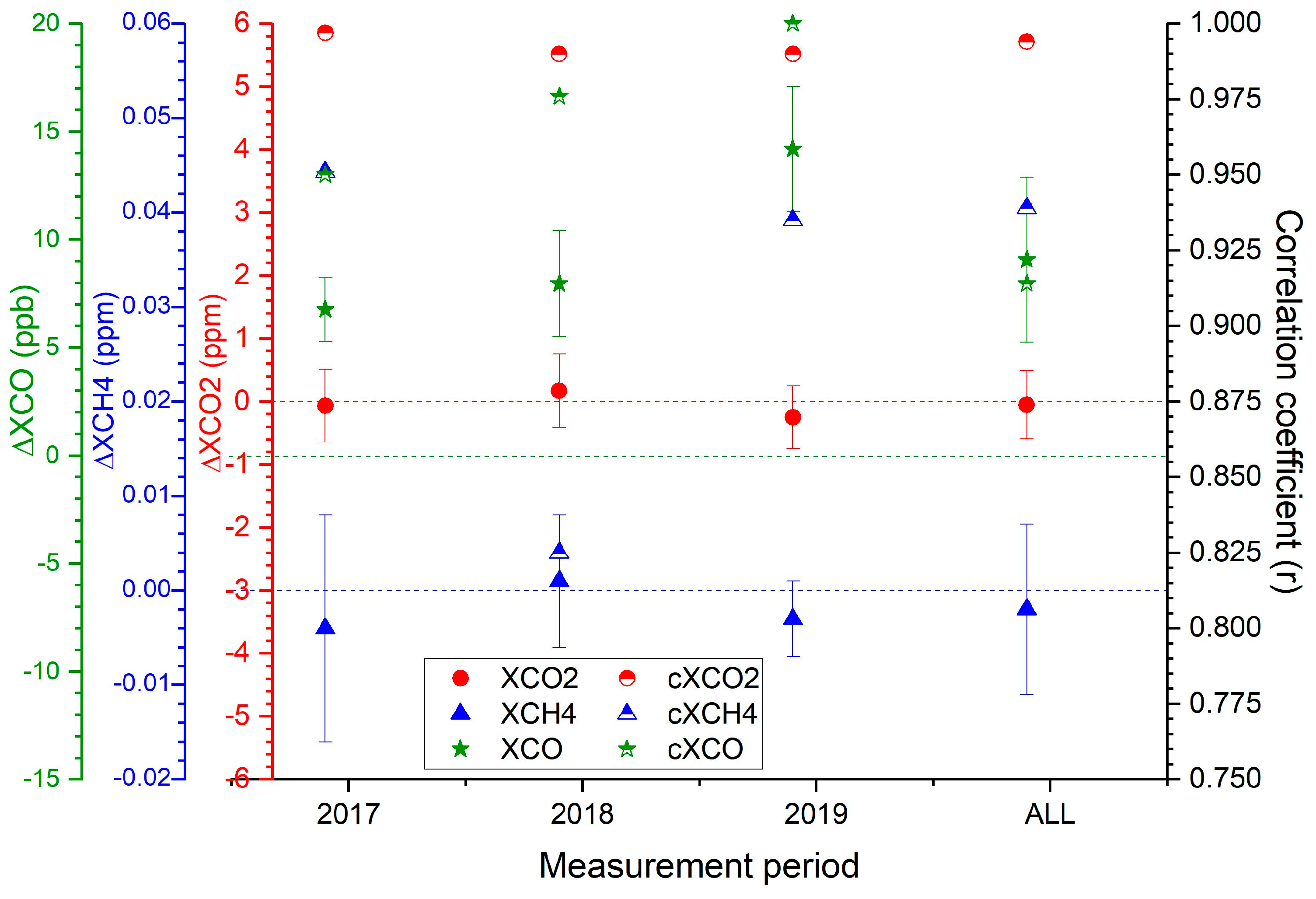
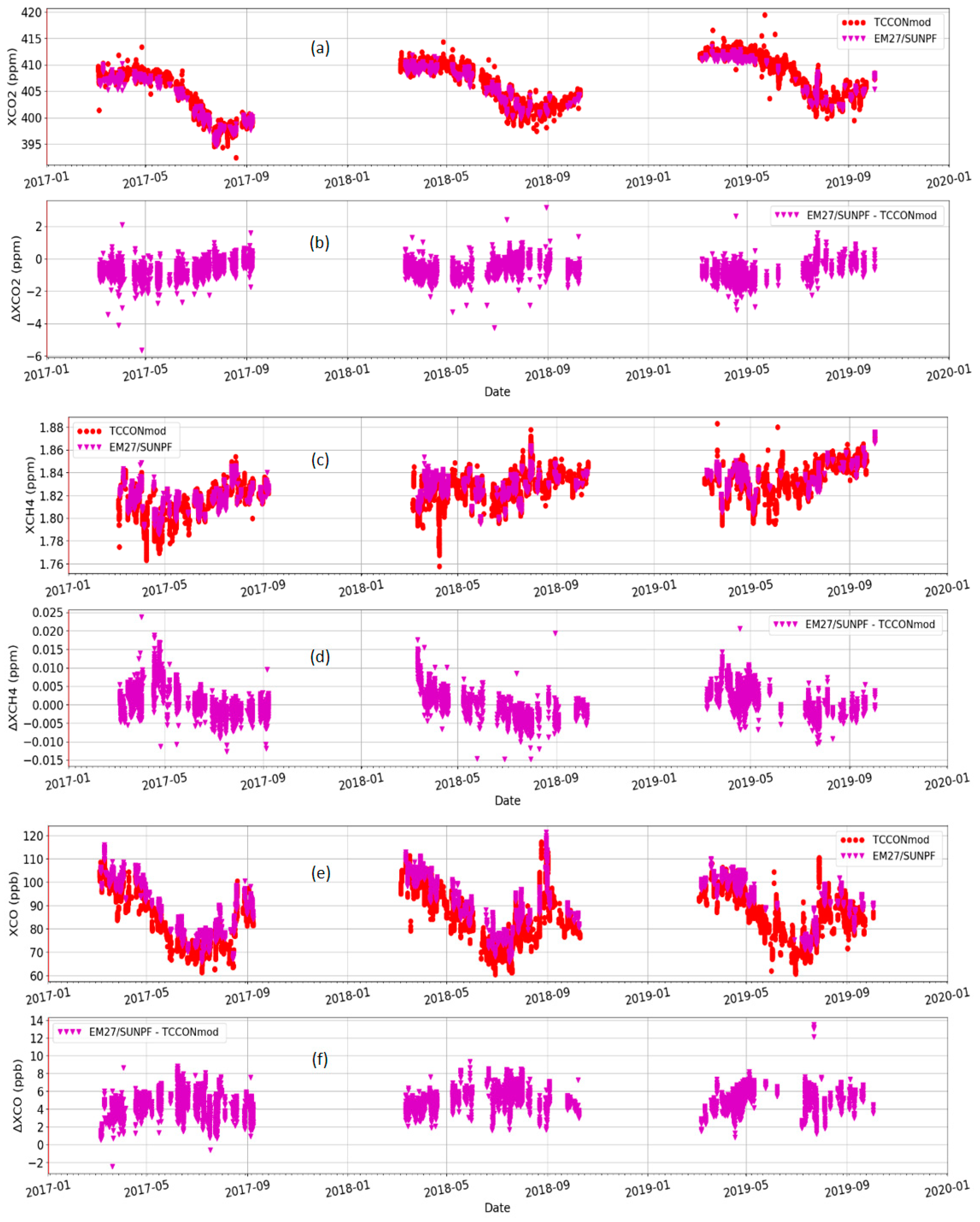
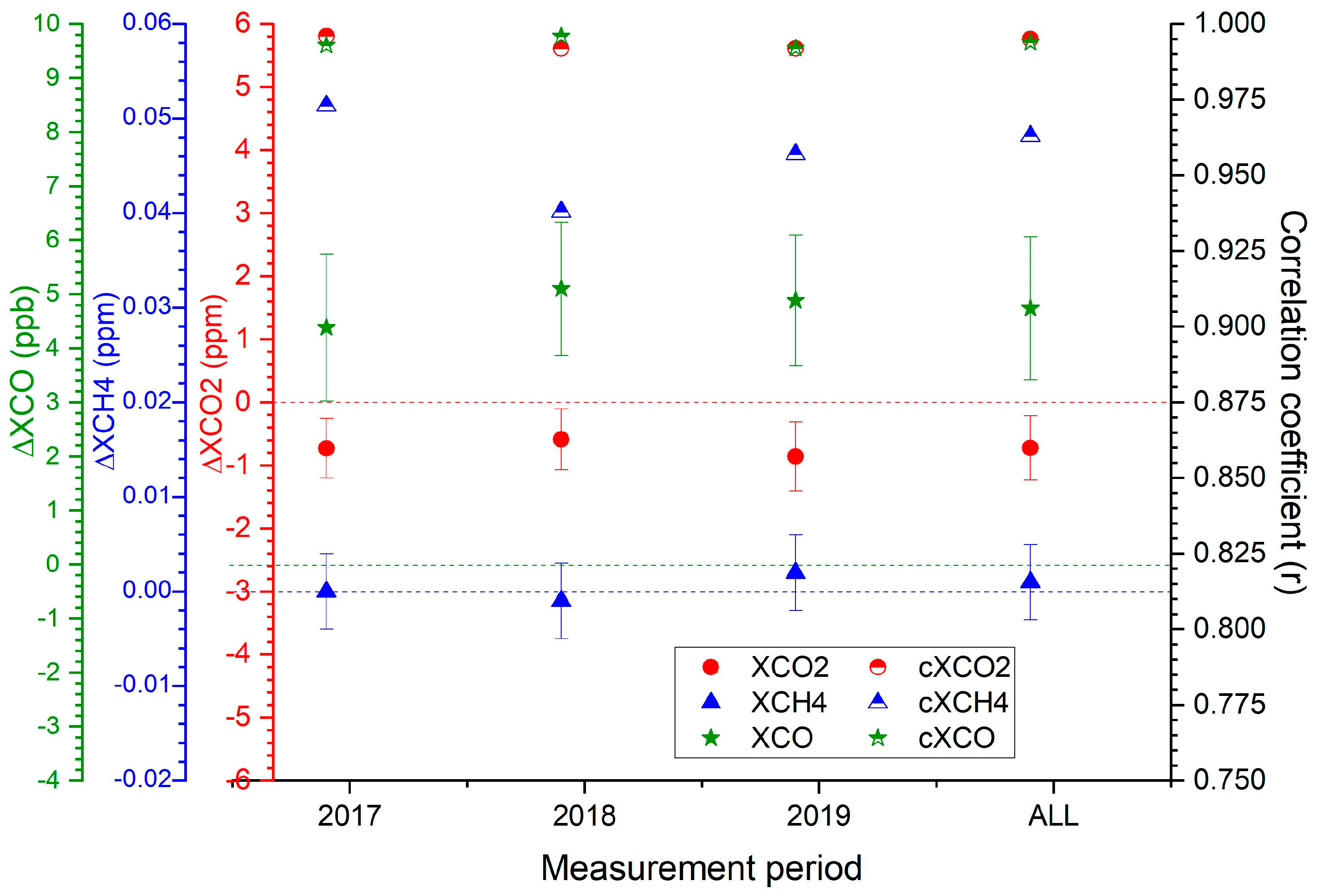

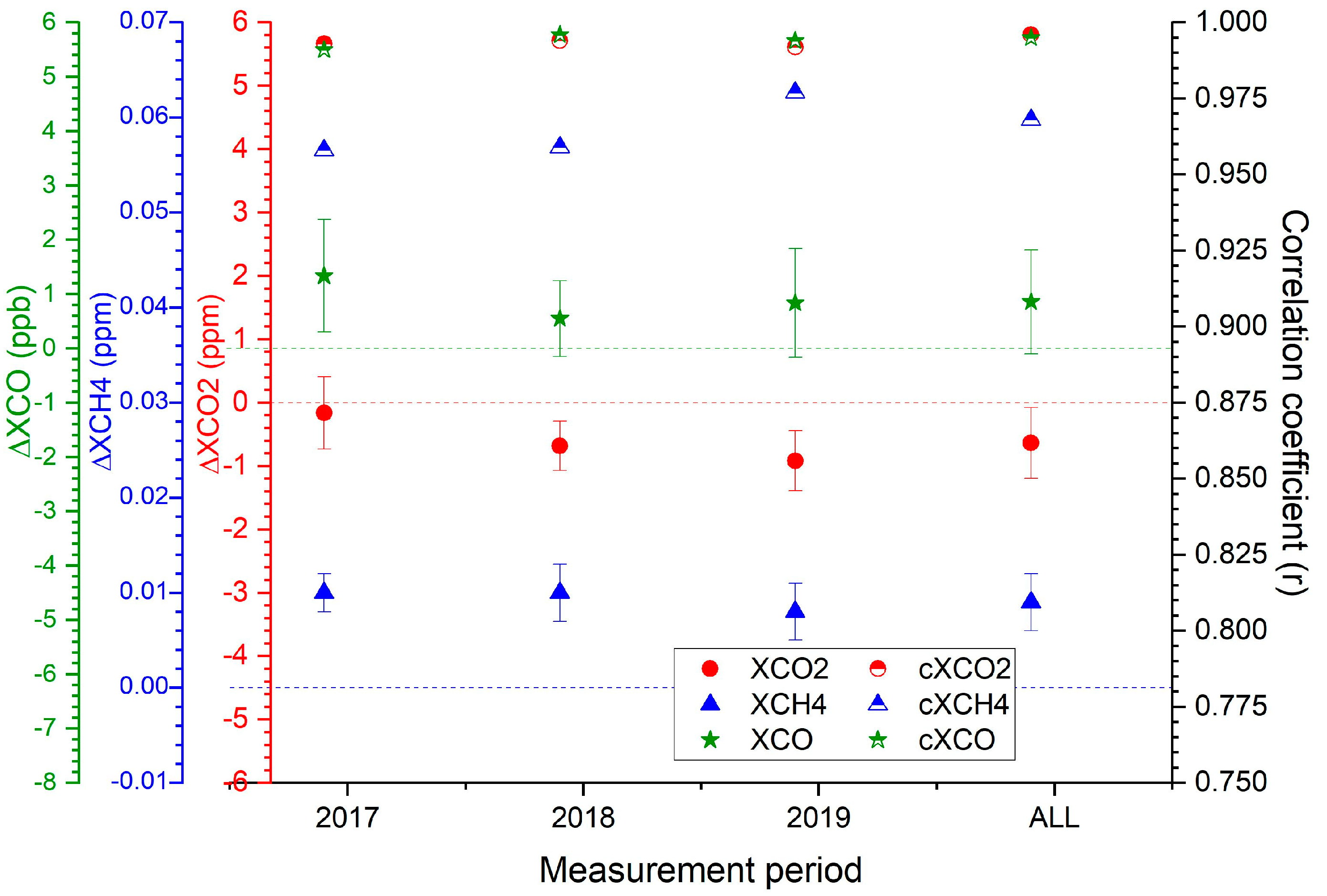
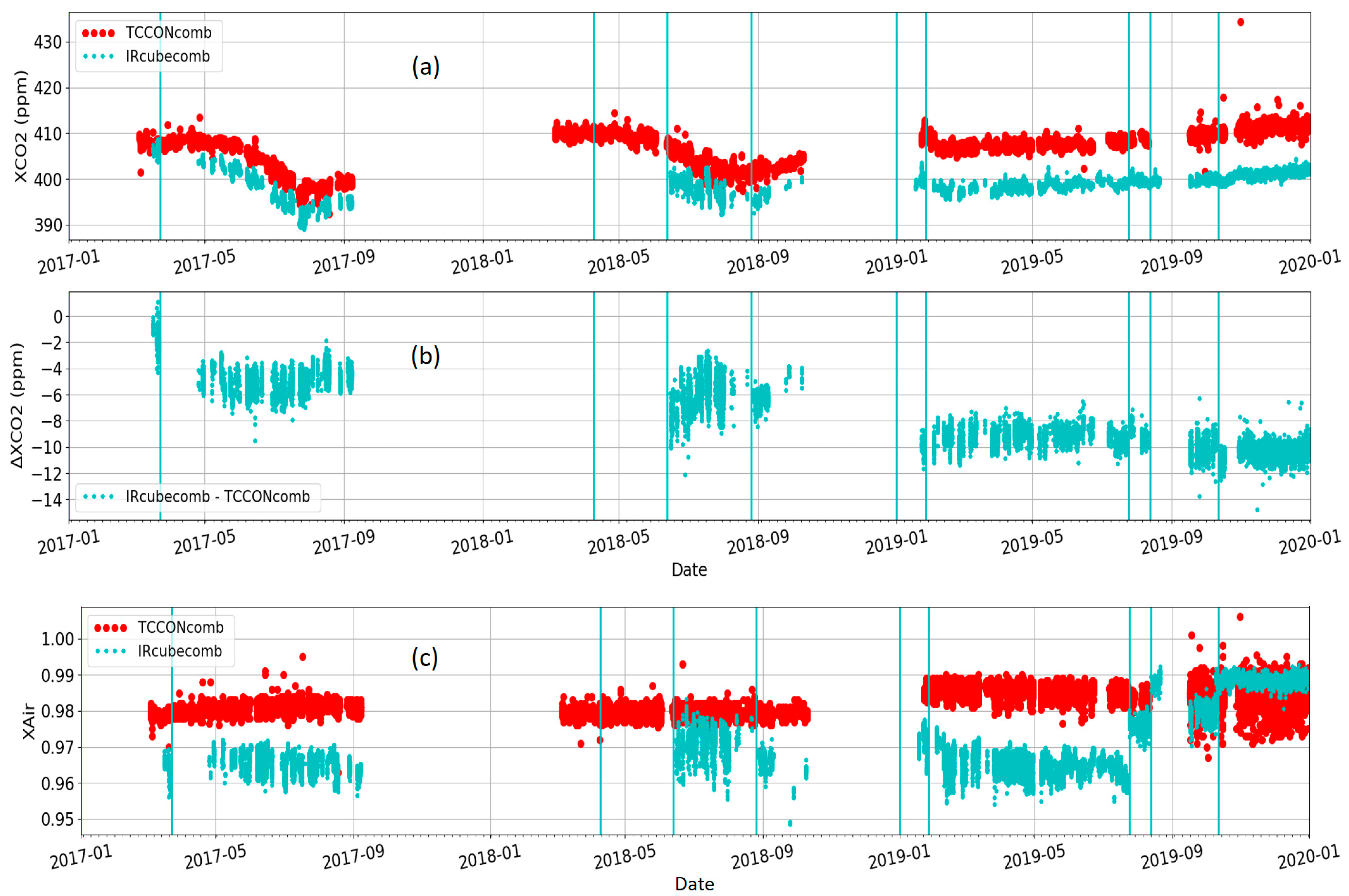

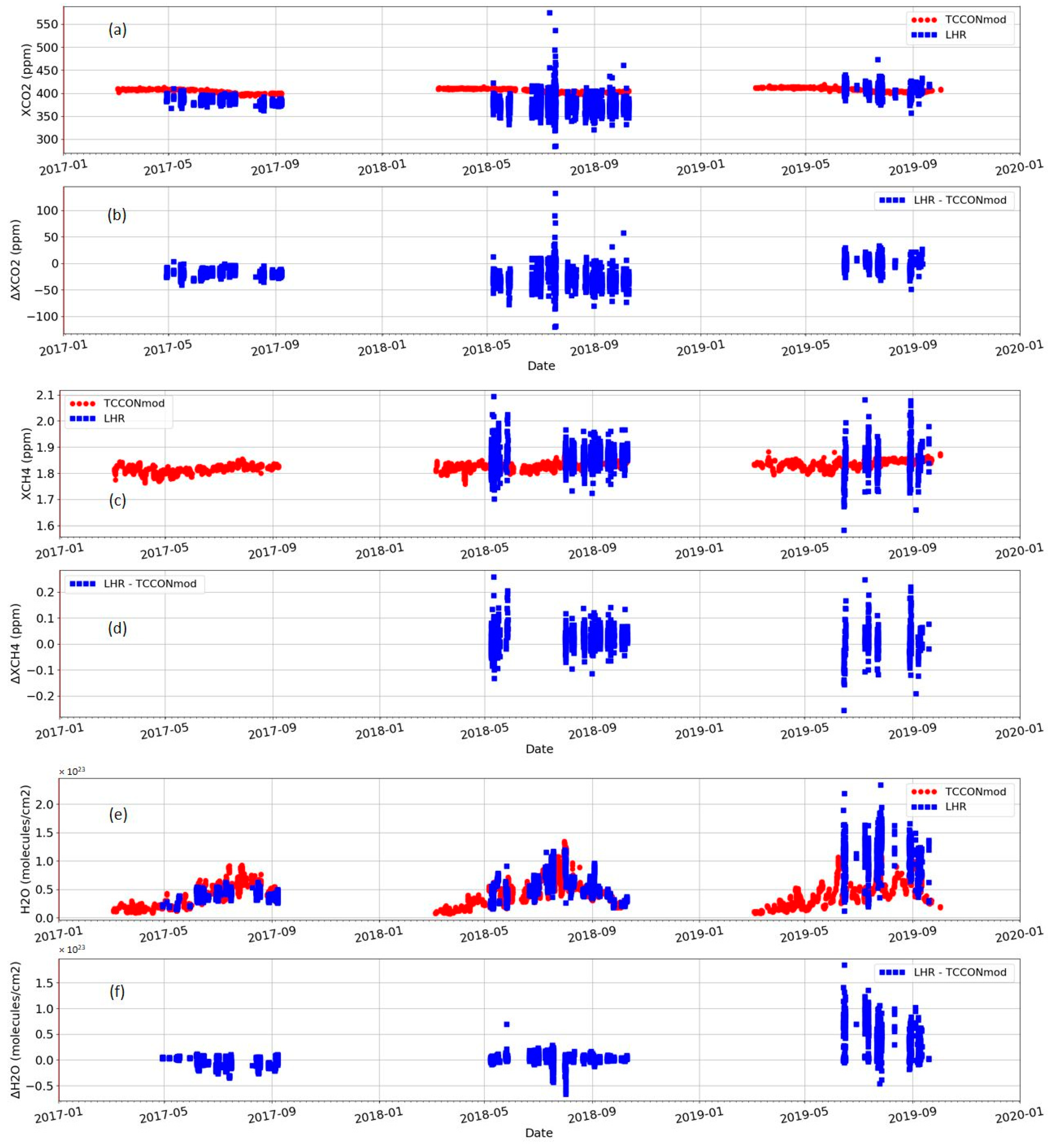
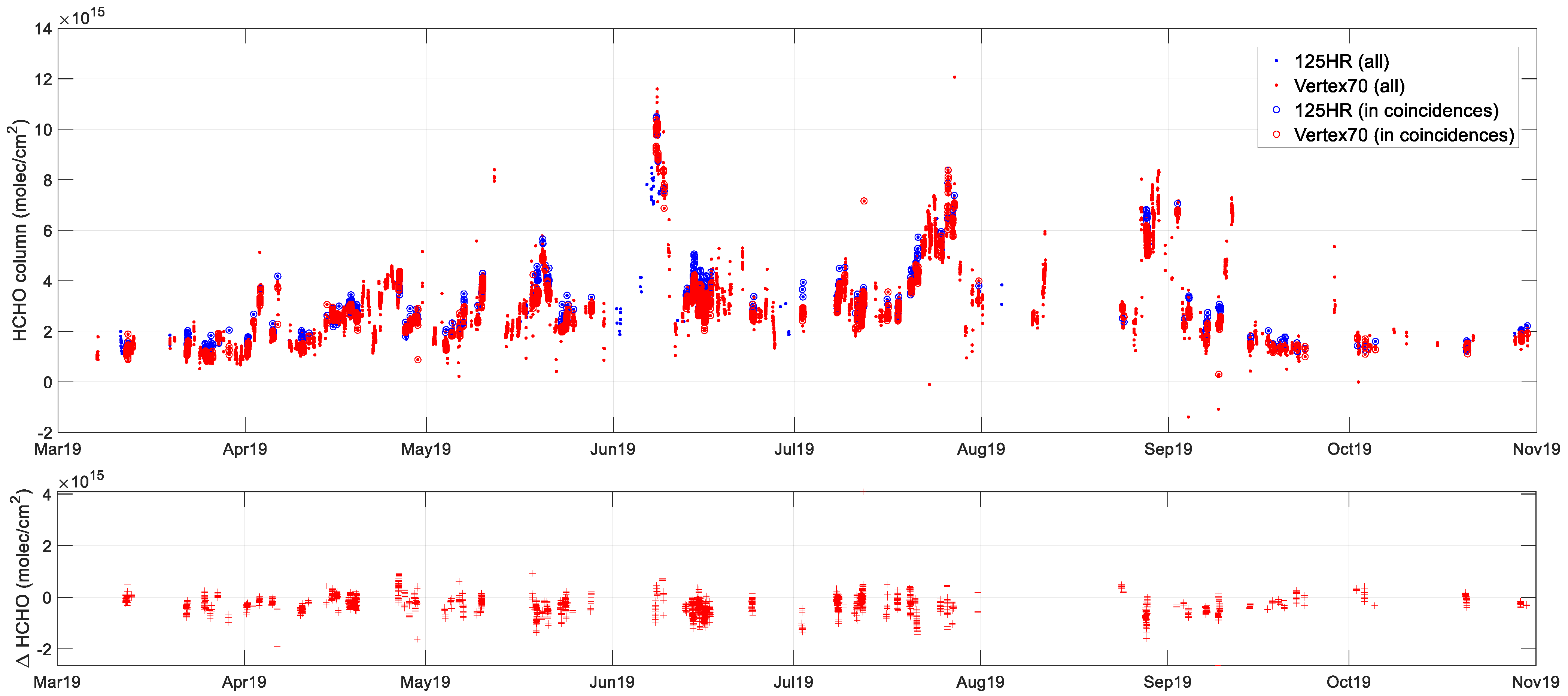
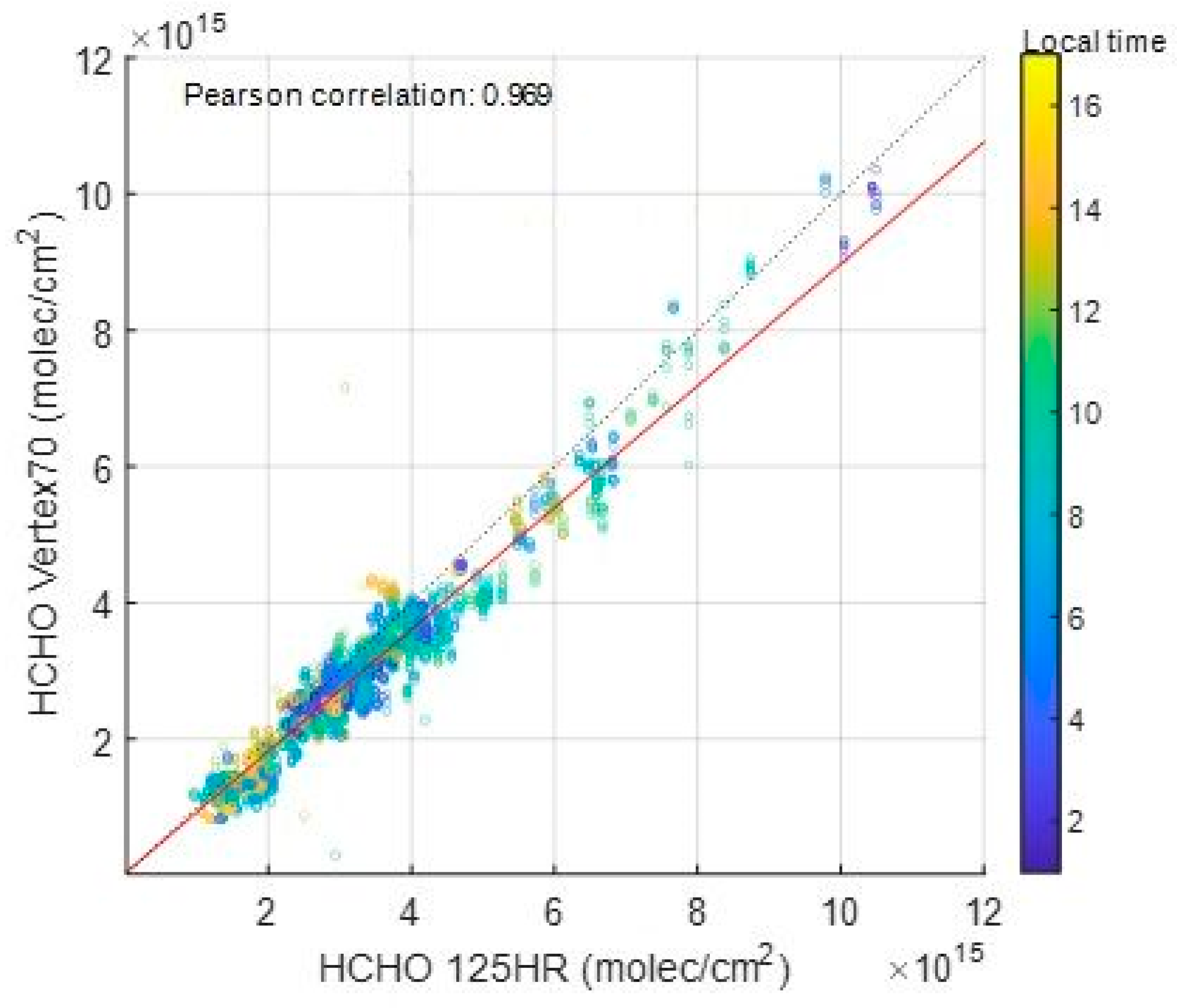

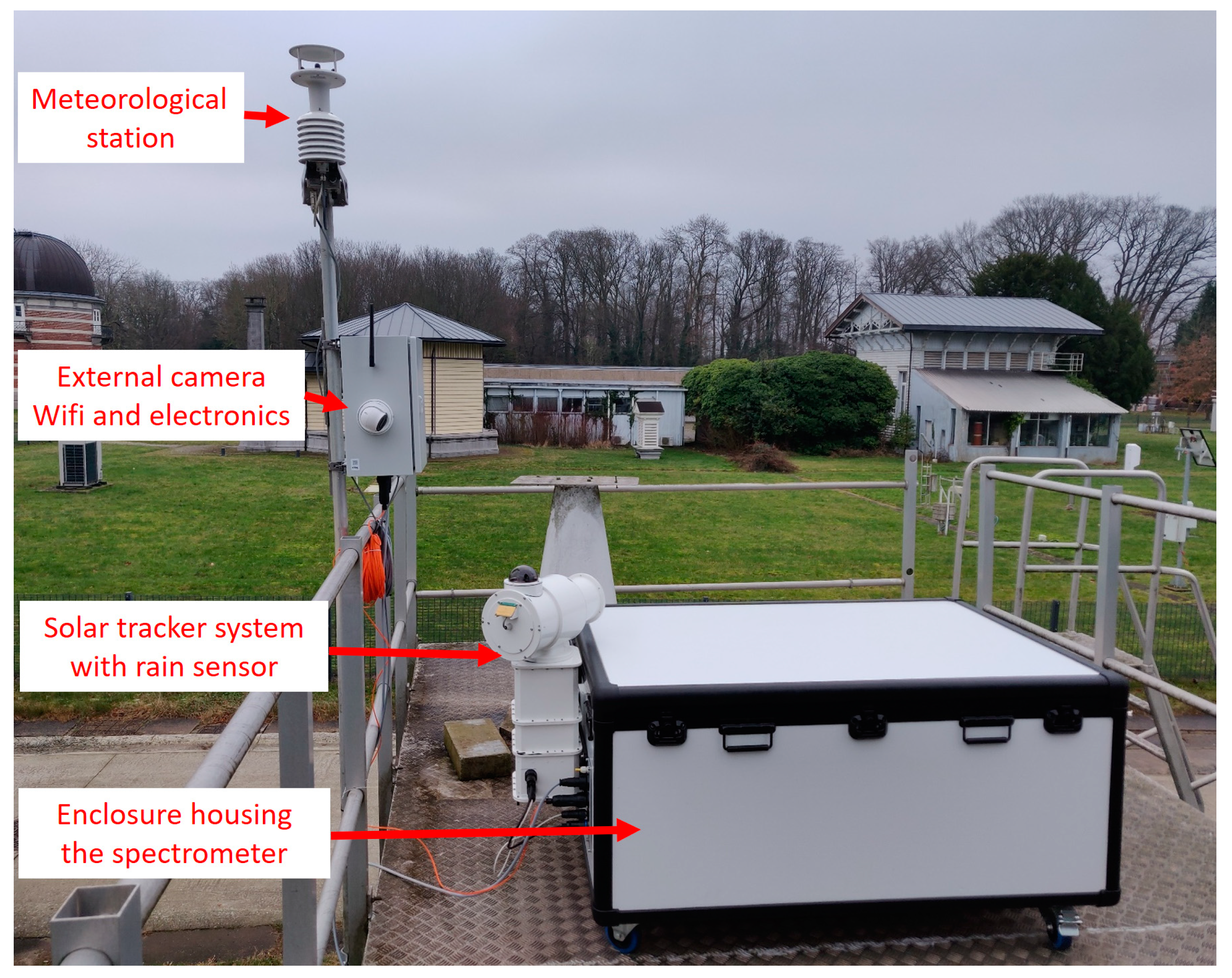

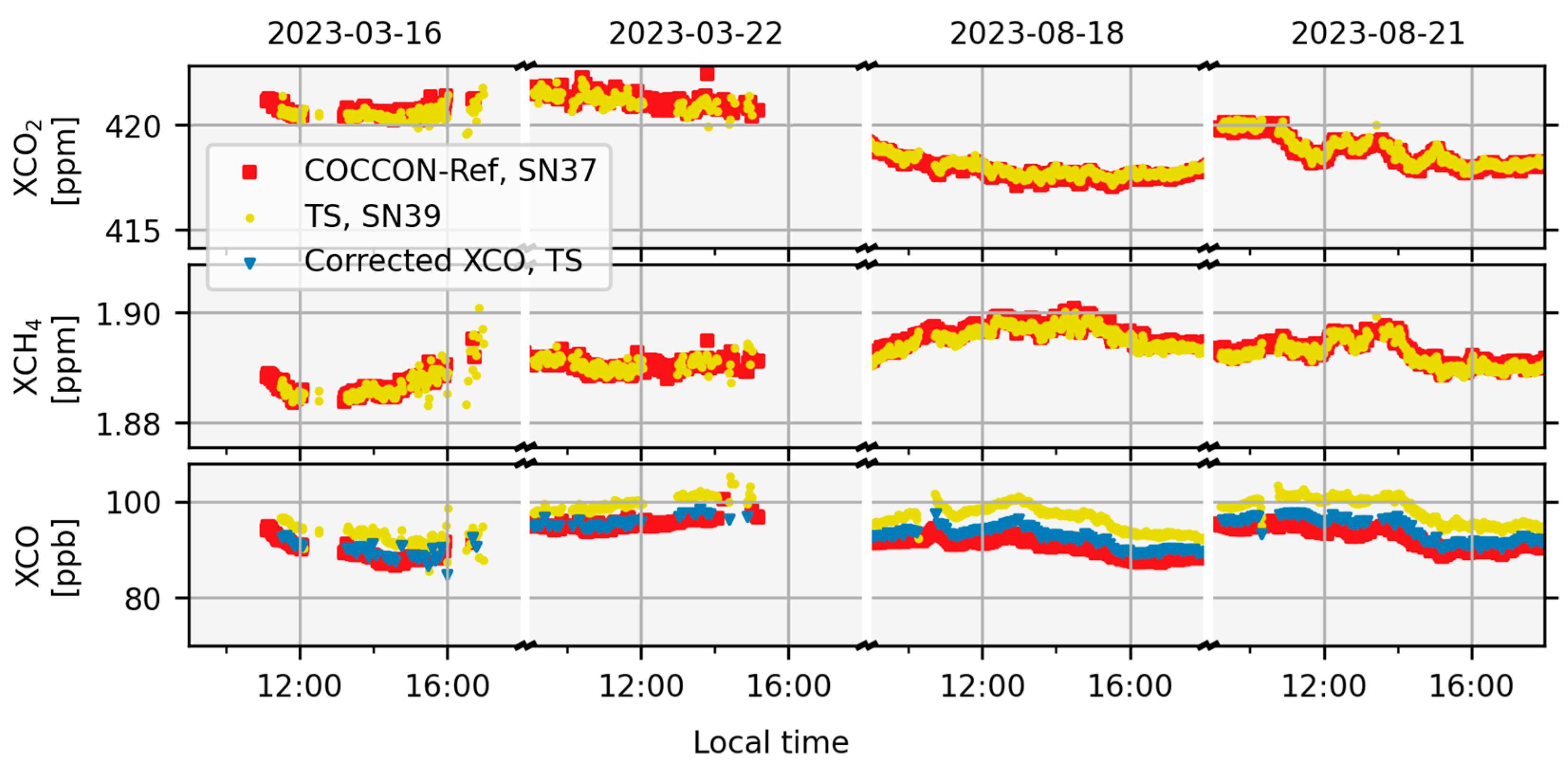


| Retrieval Code | SFIT4 |
|---|---|
| Micro-windows (cm−1) | 2763.42–2764.17 2765.65–2766.01 2778.15–2779.1 2780.65–2782.0 |
| Retrieved species | HCHO, HDO, CH4: profiles O3, N2O, H2O, solar lines: columns |
| A priori profiles | Climatology from NDACC a priori chemical profiles v6 (built from the WACCM v4 model) (except HDO and H2O) NCEP 6-hourly profiles for HDO and H2O |
| Pressure and temperature profiles | NCEP 6-hourly profiles |
| Regularization | Tikhonov L1 |
| Retrieval Code | SFIT4 |
|---|---|
| Micro-windows (cm−1) | 2047.15–2048.24 2049.17–2050.18 2054.13–2054.97 |
| Retrieved species | OCS and O3: profiles CO2, CO, H2O, C18O2, solar lines: columns |
| A priori profiles | Climatology from NDACC a priori chemical profiles v7 (built from the WACCM v5 model) (excluding H2O) monthly means NCEP 6-hourly profiles for HDO and H2O |
| Pressure and temperature profiles | NCEP 6-hourly profiles |
| Spectroscopy | HITRAN2020 |
| Regularization | Tikhonov L1 |
| Species | Date | Estimated TCCON Accuracy | |||
|---|---|---|---|---|---|
| XCO2 | March 2023 | 0.1444 ppm | – | 0.2% | |
| August 2023 | −0.1227 ppm | −0.26701 ppm (0.067%) | |||
| XCH4 | March 2023 | −0.0001 ppm | – | 0.43% | |
| August 2023 | 0.0005 ppm | 0.00060 ppm (0.03%) | |||
| XCO | March 2023 | −0.4636 ppm | – | 5.4% | |
| August 2023 | −1.6116 ppm | −1.14803 ppm (1.153%) |
| Self-Assessment | ||||
|---|---|---|---|---|
| Nature of FRM | FRM Instrumentation | Operations/Sampling | Data | Metrology |
| Descriptor | Instrument documentation | Automation level | Data completeness | Uncertainty characterization |
| Location/availability of FRM | Evidence of traceable calibration | Measurand sampling/ representativeness | Availability and usability | Traceability Documentation |
| Range of instruments | Maintenance plan | ATBD on processing: algorithm/software | Data Format | Comparison/ calibration of FRM |
| Complementary observations | Operator expertise | Guidelines on transformation to satellite pixel | Ancillary Data | Adequacy for intended class of instrument/measurand |
| Grade |
|---|
| Not assessed |
| Not assessable |
| Basic |
| Good |
| Excellent |
| Ideal |
Non-public  |
Disclaimer/Publisher’s Note: The statements, opinions and data contained in all publications are solely those of the individual author(s) and contributor(s) and not of MDPI and/or the editor(s). MDPI and/or the editor(s) disclaim responsibility for any injury to people or property resulting from any ideas, methods, instructions or products referred to in the content. |
© 2024 by the authors. Licensee MDPI, Basel, Switzerland. This article is an open access article distributed under the terms and conditions of the Creative Commons Attribution (CC BY) license (https://creativecommons.org/licenses/by/4.0/).
Share and Cite
Sha, M.K.; De Mazière, M.; Notholt, J.; Blumenstock, T.; Bogaert, P.; Cardoen, P.; Chen, H.; Desmet, F.; García, O.; Griffith, D.W.T.; et al. Fiducial Reference Measurement for Greenhouse Gases (FRM4GHG). Remote Sens. 2024, 16, 3525. https://doi.org/10.3390/rs16183525
Sha MK, De Mazière M, Notholt J, Blumenstock T, Bogaert P, Cardoen P, Chen H, Desmet F, García O, Griffith DWT, et al. Fiducial Reference Measurement for Greenhouse Gases (FRM4GHG). Remote Sensing. 2024; 16(18):3525. https://doi.org/10.3390/rs16183525
Chicago/Turabian StyleSha, Mahesh Kumar, Martine De Mazière, Justus Notholt, Thomas Blumenstock, Pieter Bogaert, Pepijn Cardoen, Huilin Chen, Filip Desmet, Omaira García, David W. T. Griffith, and et al. 2024. "Fiducial Reference Measurement for Greenhouse Gases (FRM4GHG)" Remote Sensing 16, no. 18: 3525. https://doi.org/10.3390/rs16183525
APA StyleSha, M. K., De Mazière, M., Notholt, J., Blumenstock, T., Bogaert, P., Cardoen, P., Chen, H., Desmet, F., García, O., Griffith, D. W. T., Hase, F., Heikkinen, P., Herkommer, B., Hermans, C., Jones, N., Kivi, R., Kumps, N., Langerock, B., Macleod, N. A., ... Zhou, M. (2024). Fiducial Reference Measurement for Greenhouse Gases (FRM4GHG). Remote Sensing, 16(18), 3525. https://doi.org/10.3390/rs16183525





